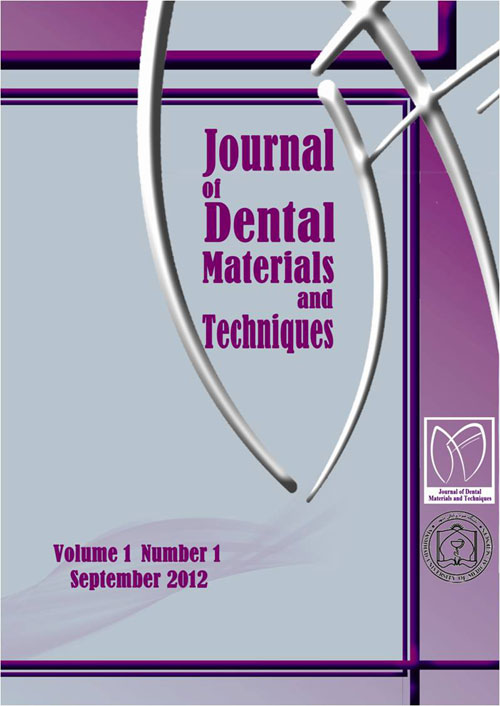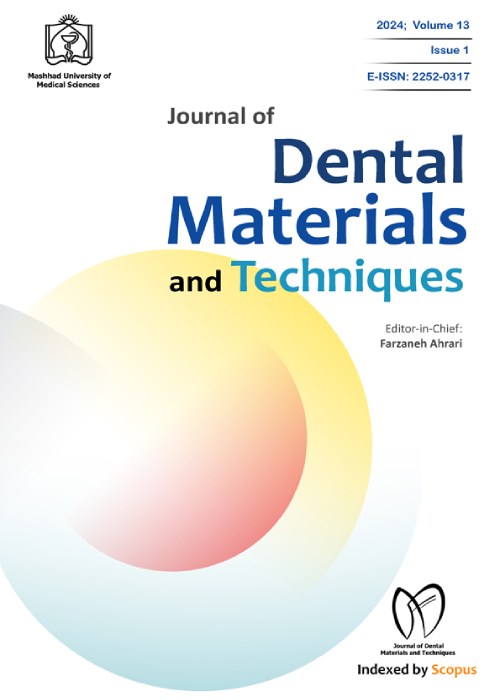فهرست مطالب

Journal of Dental Materials and Techniques
Volume:4 Issue: 3, Summer 2015
- تاریخ انتشار: 1394/05/12
- تعداد عناوین: 8
-
-
Pages 117-126IntroductionThis in-vitro study investigated the initial 24h bond strength between different composites and zirconia after application of four different adhesive systems.MethodsA total of 120 specimens of zirconia (InCoris, Sirona, Germany, Bernsheim) were ground with a 165 µm grit rotating diamond disc. Thirty specimens were each additionally treated with Cimara Zircon “CZ” (VOCO GmbH, Germany, Cuxhaven), Futurabond U “FBU” (VOCO GmbH), Futurabond M+ “FBM” (VOCO GmbH) or Futurabond M+ in combination with the DCA activator “FBMD” (VOCO GmbH). One of three different types of composites – BifixSE (“BS”), BifixQM (“BQ”) or GrandioSO (“G”) (VOCO GmbH) – was bonded to ten specimens each in every group. Shear bond strength (SBS) was determined in a universal testing machine. Statistical analysis was performed with ANOVA and the Tukey test.ResultsFBM and FBMD gave higher SBS than CZ and FBU in combination with all tested composites. In comparison to FBU, FBM gave statistically significant increases in SBS with BifixSE (19.4±5.7 MPa) (P<0.013) and with GrandioSO (19.1±4.4 MPa) (P<0.021). None of the other comparisons was statistically significant.ConclusionThe new 10-MDP-containing adhesive systems FBM and FBMD increases initial SBS between composites and zirconia in comparison to CZ and FBU.Keywords: Zirconia, 10 MDP, containing primer, composite resin, chipping, cementation
-
Pages 127-132Stafne bone defect is a bone depression containing salivary gland or fatty soft tissue on the lingual surface of the mandible. The most common location is within the submandibular gland fossa and often close to the inferior border of the mandible. This defect is asymptomatic and generally discovered only incidentally during radiographic examination of the area. Stafne bone defect appears as a well-defined, corticated, unilocular radiolucency below the mandibular canal. Although it is not uncommon for this defect to appear as a round or ovoid radiolucency, it is rarely seen as a multilocular radiolucency. This report presents a case of a developmental salivary gland defect with multilocular radiolucency above the inferior alveolar canal in a male patientKeywords: Stafne bone defect, Bilocular, inferior alveolar canal, CBCT
-
Pages 133-136A mandibular second premolar with four canals is an interesting example of anatomic variations. This report describes a case of a mandibular second premolar with three roots and four canals (one mesiobuccal, two distobuccal and one lingual). The canals were prepared using K-files and irrigated with NaOCl (5.25%) and normal saline as the final irrigant. The canals were filled laterally with gutta percha and AH26 sealer (De Trey, Dentsply, Switzerland). This case shows a rare anatomic configuration and points out the importance of looking for additional canals.Keywords: Four root canals, mandibular second premolar, three roots
-
Pages 137-142IntroductionThe purpose of the presented study was to evaluate the effect of zirconia thickness on the tensile stress of zirconia based all-ceramic restorations.MethodsTwenty zirconia disks with 10mm diameter were prepared in two groups using CAD/CAM system. The thickness of zirconia was 0.5mm in first group and 0.3mm in second group. After sintering, 0.4mm glass ceramic porcelain was applied to each disk. Then, sintering and glazing of porcelain carried out. Instron testing machine with 1mm/min crosshead speed used to evaluate the failure load of the samples. Biaxial Flexural strength standard formula employed to calculate tensile stress of specimens. Statistical analysis performed using SPSS software.ResultsAlthough data analysis showed more maximum tensile stress in 1st group, no significant differences were found between two groups.ConclusionZirconia with 0.5mm and 0.3mm thicknesses cause similar tensile stress in all-ceramic restorations and thickness of these laminates could be reduced to 0.7mm.Keywords: Zirconia, Tensile stress, Laminate
-
Pages 143-148BackgroundSurgical crown lengthening is needed for teeth with subgingival caries, fractured teeth, insufficient crown length, and deep subgingival margin of failed restorations. Since there is no agreement on the effects of crown lengthening surgery on gingival parameters, the purpose of this study was to evaluate periodontal parameters in patients who needed crown lengthening surgery.MethodsTwenty patients who had healthy periodontium and needed surgical crown lengthening were included in this study. After professional dental cleaning, gingival parameters including gingival index (GI), probing depth (PD), bone level (BL), and transsulcular probing (TSP) were recorded in interproximal and keratinized gingiva (KG) in mid buccal portion. The patients were evaluated one and three months after the surgery.ResultsAfter one and three months of the surgery, the amount of PD reduced from 2.32 mm to 1.25 mm and 1.17 mm, respectively (P=0.001). The mean of BL reduction was 0.88 mm after one month (P=0.001), but there was no reduction between 1 month and 3 months. Amounts of KG at baseline andone month later were 4.2 mm and 2.9 mm, respectively (P=0.001), and remained at the same level up to three months. TSP significantly reduced (from 3.67 mm at baseline to 2.62 mm after 1 month, and to 2.27 mm after 3 months) (P=0.001, P=0.005).ConclusionThe present study suggests that in the presence of good oral hygiene, except BW (biological width), other parameters including PD, BL, KG, and TSP had significant changes after crown lengthening surgery in the period of 1 month and 3 months (P<0.05).Keywords: Crown lengthening surgery, periodontal treatment, healthy periodontium
-
Pages 151-154IntroductionThe survival of an implant system is affected by the choice of antirotational design, which can include an external or internal hex. Implant success also is affected by the maintenance of the crestal bone around implants. The aim of present study was to evaluate the crestal bone loss and clinical parameters related to bone loss in patients loaded with an external or internal hex 3i implant (3i Implant Innovation, Palm Beach Gardens, FL, USA). The evaluations were performed one year after loading.Materials And MethodsA total of 39 implants (23 external hex, 16 internal hex) were placed randomly in 23 patients (10 male, 13 female) by a submerged approach. None of patients had compromised conditions or parafunctional habits. At placement and at one year after loading, periapical radiographs were taken via the parallel method from the implant sites.ResultsCrestal bone loss was -0.712±0.831 mm in implants with an internal hex connection and -0.139±0.505 mm in implants with an external hex connection (P≤0.05). No correlation was found between crestal bone loss and parameters such as age, gender, jaw, implant location (anterior, premolar, or molar), implant diameter, or implant length.ConclusionsCrestal bone loss was greater in patients with internal hex 3i implants than in those with external implants. Similar results in other clinical factors were found between the groups.Keywords: Implant, crestal bone loss, internal, external hex connections
-
Page 157PurposeThe aim of this study was to evaluate the effect of two gingival finishing lines (90° shoulder and deep chamfer) on the marginal fitness of two types of full anatomic all-ceramic crowns; zirconia crowns (Zikonzhan) and glass ceramic crowns (IPS e-max CAD) milled with CAD/CAM system.Materials And MethodsTwo dentoform teeth of left maxillary first molar were prepared with chamfer finishing line (CFL) and shoulder finishing line (SFL), respectively and duplicated to Nickel-Chromium master dies. Thirty two crowns were fabricated and grouped as follows: Group I: 8 zirconia crowns on CFL; Group II: 8 zirconia crowns on SFL; Group III: 8 glass ceramic crowns on CFL and Group IV: 8 glass ceramic crowns on SFL. Marginal gaps were measured at 4 indentations, each one was at center of each tooth surface and collectively 16 points were measured by using stereomicroscope (160X). The data were analyzed by One-way ANOVA and student t-tests.ResultsGroup I produced the least marginal gap (73.55µm); followed by Group II (92.60µm), and Group III (151.45µm) and the highest marginal gap was recorded by Group IV (162.34µm). Statistical analysis of the data showed that SFL produced significantly greater marginal gap on zirconia crowns in comparison with CFL. However, in glass ceramic crowns, CFL revealed less marginal gap compared to SFL but statistically was not significant. On the other hand, glass ceramic crowns significantly produced a greater marginal gap in comparison to zirconia crowns regardless type of finishing line.Conclusionsdeep chamfer margin could be more preferable finishing line than 90° shoulder especially for zirconia full crowns. Furthermore, zirconia crowns could be more advisable than glass ceramic crowns in respect to marginal adaptation.Keywords: CAD, CAM system, Marginal fitness, Zirconia, glass ceramics, shoulder finishing lines, chamfer finishing lines


